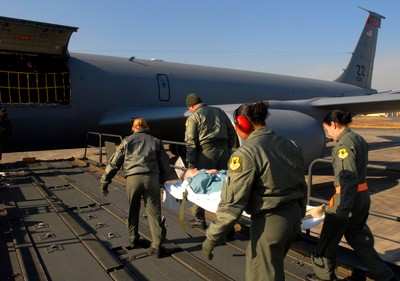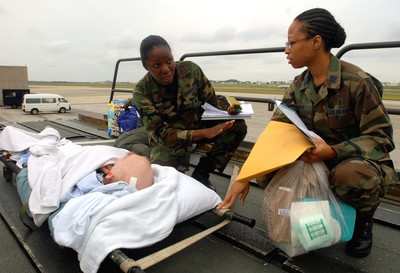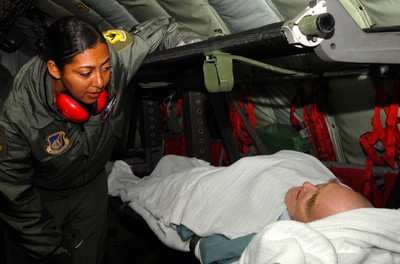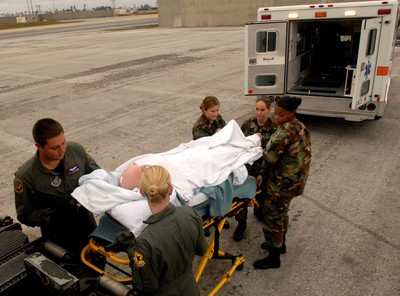 Airmen from the 18th Aeromedical
Evacuation Squadron at Kadena Air Base recently were kept busy
while 'aerovacing' patients on a KC-135 Stratotanker Dec. 18 from
Yokota Air Base, Japan. Members of the 18th AES travel throughout
the Pacific picking up critical patients and transporting them to
hospitals that can meet their needs.
Airmen from the 18th Aeromedical
Evacuation Squadron at Kadena Air Base recently were kept busy
while 'aerovacing' patients on a KC-135 Stratotanker Dec. 18 from
Yokota Air Base, Japan. Members of the 18th AES travel throughout
the Pacific picking up critical patients and transporting them to
hospitals that can meet their needs.
Every week a team of medical professionals here cares for
critically-ill patients being evacuated by air from bases around
the Pacific. Airmen from the 18th AES use a combination of medical
expertise, state-of-the-art equipment and human compassion to
provide in-flight care to patients until they can be transferred to
a facility that offers a higher level of care.
The members of the 18th AES fly aboard Kadena AB-based KC-135s
from the 909th Air Refueling Squadron, making regular weekly runs
to airlift patients from bases in South Korea and mainland Japan.
They can also respond at a moment's notice to medical emergencies
all over the region.
"There is no predictability to our mission," said Col. Terri
Reusch, the 18th AES commander.
"We call it the 911 service. Need help? Call us and we'll get
you where you need to go." The squadron's primary mission is to
support medical operations in wartime, during contingencies and
during natural disaster relief operations that occur within the
Pacific theater. Airmen of the 18th AES, along with their partners
in the 909th ARS, maintain a 24-hour alert for emergencies outside
the weekly patient pick-up schedule.

"We have people responding at a moment's notice and qualified to
care for critical patients until the proper care is available,"
Colonel Reusch said. "It takes a lot of coordination." The
ability of the squadron to mobilize quickly, using timely airlift
and the most advanced equipment available means that patients
receive the critical care they need in flight to survive and
recover from serious illnesses and injuries.
"Within 36 hours we can have patients moved to Walter Reed Army
Medical Center in Washington, D.C." Colonel Reusch said. Squadron
members stand ready to provide advanced in-flight medical care for
more than 540,000 beneficiaries in the Pacific, primarily military
members, families, and Department of Defense civilians, said Capt.
Deborah Willis, an 18th AES flight nurse.

Patients may receive care from the 18th AES for hours and
sometimes even days as they are transported from one location to
the other. The key is preparation, Captain Willis said.
"We configure the aircraft for our patients, whether they are
litter or ambulatory," the captain said. "We make sure that we have
everything we need in the aircraft." Typically working in
five-person teams, the members of the 18th AES aim to get patients
to the next level of care quickly and safely.

"Patient safety and stability is our only focus until we get the
patients to the hospital," said Staff Sgt. Zurkina Gunter, an 18th
AES aeromedical evacuation technician. The versatility of the
squadron means that it can provide the same high level of care
aboard a variety of Air Force platforms.
"Any available aircraft can be diverted to carry passengers or
patients, whether it's a C-17 (Globemaster III), C-130 (Hercules)
or KC-10 (Extender)," Colonel Reusch said. [ANN Salutes Tech. Sgt.
Rey Ramon, 18th Wing Public Affairs]

 ANN's Daily Aero-Term (04.20.24): Light Gun
ANN's Daily Aero-Term (04.20.24): Light Gun Aero-News: Quote of the Day (04.20.24)
Aero-News: Quote of the Day (04.20.24) ANN's Daily Aero-Linx (04.21.24)
ANN's Daily Aero-Linx (04.21.24) Aero-News: Quote of the Day (04.21.24)
Aero-News: Quote of the Day (04.21.24) ANN's Daily Aero-Term (04.21.24): Aircraft Conflict
ANN's Daily Aero-Term (04.21.24): Aircraft Conflict







